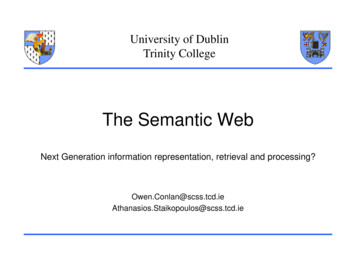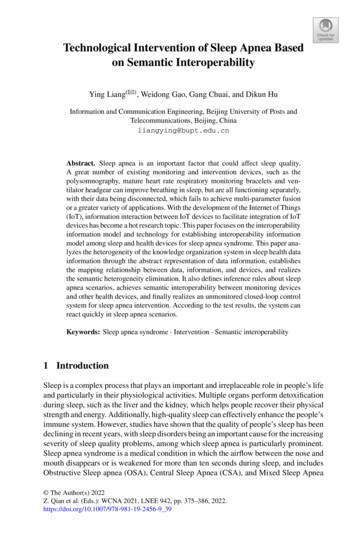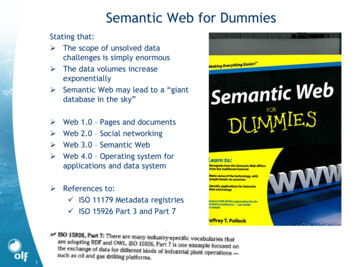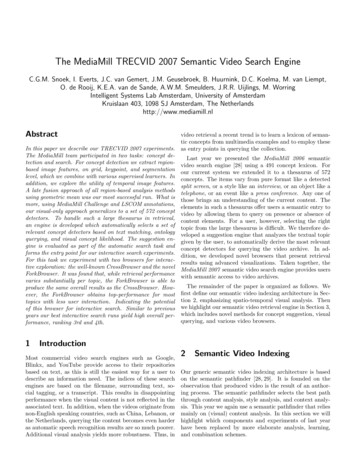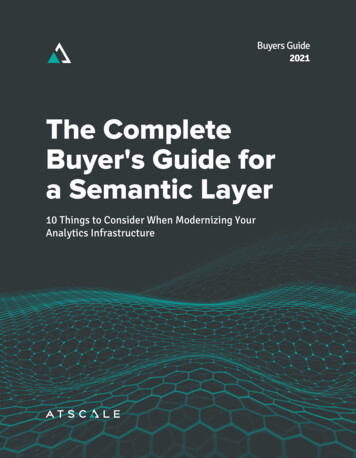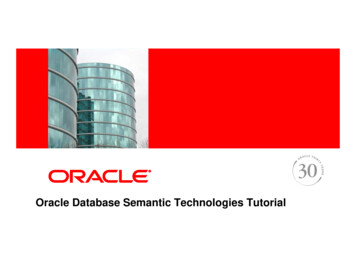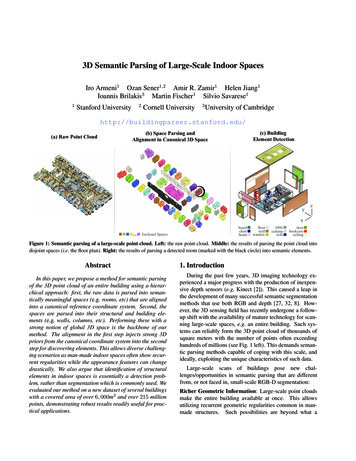
Transcription
1Introduction to the Semantic Web(tutorial)2009 Semantic Technology ConferenceSan Jose, California, USAJune 15, 2009Ivan Herman, W3Civan@w3.org
2Introduction
3Let’s organize a trip to Budapest using theWeb!
4You try to find a proper flight with
a big, reputable airline, or 5
6 the airline of the target country, or
or a low cost one7
8You have to find a hotel, so you look for
a really cheap accommodation, or 9
or a really luxurious one, or 10
an intermediate one 11
12oops, that is no good, the page is inHungarian that almost nobodyunderstands, but
this one could work13
14Of course, you could decide to trust aspecialized site
like this one, or 15
or this one16
17You may want to know something aboutBudapest; look for some photographs
on flickr 18
on Google 19
or you can look at mine20
or a (social) travel site21
What happened here? You had to consult a large number of sites, alldifferent in style, purpose, possibly language You had to mentally integrate all those informationto achieve your goalsWe all know that, sometimes, this is a long andtedious process!22
23 All those pages are only tips of respective icebergs: the real data is hidden somewhere in databases, XML files,Excel sheets, you have only access to what the Web page designersallow you to see
24 Specialized sites (Expedia, TripAdvisor) do a bitmore: they gather and combine data from other sources (usuallywith the approval of the data owners)but they still control how you see those sourcesBut sometimes you want to personalize: access theoriginal data and combine it yourself!
Here is another example 25
26Another example: social sites. I have a listof “friends” by
Dopplr,27
Twine,28
LinkedIn,29
and, of course, Facebook30
31 I had to type in and connect with friends again andagain for each site independentlyThis is even worse then before: I feed the icebergs,but I still do not have an easy access to data
What would we like to have? Use the data on the Web the same way as we dowith documents: be able to link to data (independently of their presentation)use that data the way I want (present it, mine it, etc)agents, programs, scripts, etc, should be able to interpretpart of that data32
Put it another way We would like to extend the current Web to a “Webof data”: allow for applications to exploit the data directly33
34But wait! Isn’t what mashup sites arealready doing?
A “mashup” example:35
36 In some ways, yes, and that shows the huge powerof what such Web of data providesBut mashup sites are forced to do very ad-hoc jobs various data sources expose their data via Web Serviceseach with a different API, a different logic, different structurethese sites are forced to reinvent the wheel many timesbecause there is no standard way of doing things
Put it another way (again) We would like to extend the current Web to astandard way for a “Web of data”37
But what does this mean? What makes the current (document) Web work? people create different documentsthey give an address to it (ie, a URI) and make it accessibleto others on the Web38
Steven’s site on Amsterdam(done for some visiting friends)39
Then some magic happens Others discover the site and they link to itThe more they link to it, the more important andwell known the page becomes remember, this is what, eg, Google exploits!This is the “Network effect”: some pages becomeimportant, and others begin to rely on it even if theauthor did not expect it 40
This could be expected 41
but this one, from the other side of the Globe,was not 42
What would that mean for a Web of Data? Lessons learned: we should be able to: “publish” the data to make it known on the Web make it possible to “link” to that URI from other sources ofdata (not only Web pages) standard ways should be used instead of ad-hoc approachesthe analogous approach to documents: give URI-s to the dataie, applications should not be forced to make targeteddevelopments to access the datageneric, standard approaches should sufficeand let the network effect work its way 43
But it is a little bit more complicated On the traditional Web, humans are implicitly takeninto accountA Web link has a “context” that a person may use44
Eg: address field on my page:45
leading to this page46
47 A human understands that this is my institution’shome pageHe/she knows what it means (realizes that it is aresearch institute in Amsterdam)On a Web of Data, something is missing; machinescan’t make sense of the link alone
48 New lesson learned: extra information (“label”) must be added to a link: “this linksto my institution, which is a research institute”this information should be machine readablethis is a characterization (or “classification”) of both the linkand its targetin some cases, the classification should allow for somelimited “reasoning”
Let us put it together What we need for a Web of Data: use URI-s to publish data, not only full documentsallow the data to link to other datacharacterize/classify the data and the links (the “terms”) toconvey some extra meaningand use standards for all these!49
50So What is the Semantic Web?
51It is a collection of standard technologiesto realize a Web of Data
52 It is that simple Of course, the devil is in the details a common model has to be provided for machines todescribe, query, etc, the data and their connectionsthe “classification” of the terms can become very complexfor specific knowledge areas: this is where ontologies,thesauri, etc, enter the game
53In what follows We will use a simplistic example to introduce themain technical conceptsThe details will be for later during the course
The rough structure of data integration541. Map the various data onto an abstract datarepresentation make the data independent of its internal representation 2. Merge the resulting representations3. Start making queries on the whole! queries that could not have been done on the individual datasets
A simplified bookstore data (dataset “A”)IDISBN0-00-651409-XAuthor Titleid xyz The Glass PalacePublisherid qprIDid xyzNameGhosh, AmitavHome Pagehttp://www.amitavghosh.comIDid qprPubl. NameHarper CollinsCityLondonYear200055
1 : export your data as a set of relationsst56
Some notes on the exporting the data Relations form a graph the nodes refer to the “real” data or contain some literalhow the graph is represented in machine is immaterial fornowData export does not necessarily mean physicalconversion of the data relations can be generated on-the-fly at query time via SQL “bridges”scraping HTML pagesextracting data from Excel sheetsetc.One can export part of the data57
Another bookstore data (dataset “F”)A17111213DEIDISBN0 2020386682TraducteurTitreOriginalLe Palais XAuteurA12236BNomGhosh, AmitavBesse, Christianne58
nd2 : export your second set of data59
rd3 : start merging your data60
rd3 : start merging your data (cont.)61
rd3 : merge identical resources62
Start making queries User of data “F” can now ask queries like: “give me the title of the original” well, « donnes-moi le titre de l’original » This information is not in the dataset “F” but can be retrieved by merging with dataset “A”!63
However, more can be achieved We “feel” that a:author and f:auteur should bethe sameBut an automatic merge doest not know that!Let us add some extra information to the mergeddata: a:author same as f:auteurboth identify a “Person”a term that a community may have already defined: a “Person” is uniquely identified by his/her name and, say,homepageit can be used as a “category” for certain type of resources64
3rd revisited: use the extra knowledge65
Start making richer queries! User of dataset “F” can now query: “donnes-moi la page d’accueil de l’auteur de l’originale” well “give me the home page of the original’s ‘auteur’” The information is not in datasets “F” or “A” but was made available by: merging datasets “A” and datasets “F”adding three simple extra statements as an extra “glue”66
Combine with different datasets Using, e.g., the “Person”, the dataset can becombined with other sourcesFor example, data in Wikipedia can be extractedusing dedicated tools e.g., the “dbpedia” project can extract the “infobox”information from Wikipedia already 67
Merge with Wikipedia data68
Merge with Wikipedia data69
Merge with Wikipedia data70
Is that surprising? It may look like it but, in fact, it should not be What happened via automatic means is done everyday by Web users!The difference: a bit of extra rigour so thatmachines could do this, too71
What did we do? We combined different datasets that are somewhere on the webare of different formats (mysql, excel sheet, XHTML, etc)have different names for relationsWe could combine the data because some URI-swere identical (the ISBN-s in this case)We could add some simple additional information(the “glue”), possibly using common terminologiesthat a community has producedAs a result, new relations could be found andretrieved72
It could become even more powerful We could add extra knowledge to the mergeddatasets This is where ontologies, extra rules, etc, come in e.g., a full classification of various types of library datageographical informationetc.ontologies/rule sets can be relatively simple and small, orhuge, or anything in between Even more powerful queries can be asked as aresult73
What did we do? (cont)74
75The Basis: RDF
RDF triples Let us begin to formalize what we did! we “connected” the data but a simple connection is not enough data should benamed somehowhence the RDF Triples: a labelled connection between tworesources76
RDF triples (cont.) An RDF Triple (s,p,o) is such that: “s”, “p” are URI-s, ie, resources on the Web; “o” is a URI ora literal “s”, “p”, and “o” stand for “subject”, “property”, and “object”here is the complete triple:( http:// isbn 6682 ,( http:// isbn 6682 , http:// /original , http:// /original , http:// isbn 409X ) http:// isbn 409X ) RDF is a general model for such triples (withmachine readable formats like RDF/XML, Turtle,N3, RXR, )77
RDF triples (cont.) Resources can use any URI, e.g.: URI-s can also denote non Web entities: .org/file2.xml#xpath1(//q[@a b])http://www.ivan-herman.net/me is menot my home page, not my publication list, but meRDF triples form a directed, labelled graph78
79A simple RDF example (in RDF/XML) rdf:Description rdf:Description rdf:about "http:// /isbn/2020386682" rdf:about "http:// /isbn/2020386682" f:titrexml:lang "fr" Le f:titre xml:lang "fr" Le palaispalais desdes mirroirs /f:titre mirroirs /f:titre f:originalrdf:resource "http:// /isbn/000651409X"/ f:original rdf:resource "http:// /isbn/000651409X"/ /rdf:Description /rdf:Description (Note: namespaces are used to simplify the URI-s)
A simple RDF example (in Turtle) http:// /isbn/2020386682 http:// /isbn/2020386682 f:titref:titre "Le"Le palaispalais desdes mirroirs"@frmirroirs"@fr ;;f:originalf:original http:// /isbn/000651409X http:// /isbn/000651409X .80
“Internal” nodes Consider the following statement: “the publisher is a «thing» that has a name and an address” Until now, nodes were identified with a URI. But what is the URI of «thing»?81
Internal identifier (“blank nodes”) rdf:Description rdf:Description rdf:about "http:// /isbn/000651409X" rdf:about "http:// /isbn/000651409X" a:publisherrdf:nodeID "A234"/ a:publisher rdf:nodeID "A234"/ /rdf:Description /rdf:Description rdf:Description rdf:Description rdf:nodeID "A234" rdf:nodeID "A234" a:p name HarpersCollins /a:p name a:p name HarpersCollins /a:p name a:city HarpersCollins /a:city a:city HarpersCollins /a:city /rdf:Description /rdf:Description http:// /isbn/2020386682 http:// /isbn/2020386682 a:publishera:publisher :A234.:A234.:A234a:p name"HarpersCollins".:A234 a:p name "HarpersCollins". Syntax is serialization dependentA234 is invisible from outside (it is not a “real”URI!); it is an internal identifier for a resource82
83Blank nodes: the system can also do it Let the system create a “nodeID” internally (you donot really care about the name ) rdf:Description rdf:Description rdf:about "http:// /isbn/000651409X" rdf:about "http:// /isbn/000651409X" a:publisher a:publisher rdf:Description rdf:Description a:p name HarpersCollins /a:p name a:p name HarpersCollins /a:p name /rdf:Description /rdf:Description /a:publisher /a:publisher /rdf:Description /rdf:Description
Same in Turtle http:// /isbn/000651409X http:// /isbn/000651409X a:publishera:publisher [[a:p namea:p name "HarpersCollins";"HarpersCollins"; ].].84
Blank nodes: some more remarks Blank nodes require attention when merging blanks nodes with identical nodeID-s in different graphs aredifferentimplementations must be careful Many applications prefer not to use blank nodesand define new URI-s “on-the-fly”85
RDF in programming practice For example, using Java Jena (HP’s Bristol Lab): a “Model” object is createdthe RDF file is parsed and results stored in the Modelthe Model offers methods to retrieve: triples(property,object) pairs for a specific subject(subject,property) pairs for specific objectetc.the rest is conventional programming Similar tools exist in Python, PHP, etc.86
Jena example//// createcreate aa modelmodelModelmodel newModel model new ModelMem();ModelMem();ResourceResource subject model.createResource("URI of Subject")subject model.createResource("URI of Subject")//'in'refers// 'in' refers toto thethe inputinput .read(new InputStreamReader(in));StmtIteratorStmtIterator iter model.listStatements(subject,null,null);iter .hasNext())while(iter.hasNext()) {{stst iter.next();iter.next();pp st.getProperty();st.getProperty();oo st.getObject();st.getObject();do something(p,o);do something(p,o);}}87
Merge in practice Environments merge graphs automatically e.g., in Jena, the Model can load several filesthe load merges the new statements automatically88
Example: integrate experimental data Goal: reuse of olderexperimental dataKeep data indatabases or XML,just export key “fact”as RDFUse a facetedbrowser to visualizeand interact with theresultCourtesy of Nigel Wilkinson, Lee Harland, Pfizer Ltd, Melliyal Annamalai, Oracle (SWEO Case Study)89
90One level higher up(RDFS, Datatypes)
Need for RDF schemas First step towards the “extra knowledge”: define the terms we can usewhat restrictions applywhat extra relationships are there?Officially: “RDF Vocabulary Description Language” the term “Schema” is retained for historical reasons 91
Classes, resources, Think of well known traditional ontologies ortaxonomies: use the term “novel”“every novel is a fiction”“«The Glass Palace» is a novel”etc.RDFS defines resources and classes: everything in RDF is a “resource”“classes” are also resources, but they are also a collection of possible resources (i.e.,“individuals”) “fiction”, “novel”, 92
Classes, resources, (cont.) Relationships are defined among classes andresources: “typing”: an individual belongs to a specific class “«The Glass Palace» is a novel”to be more precise: “«http://./000651409X» is a novel”“subclassing”: all instances of one are also the instances ofthe other (“every novel is a fiction”)RDFS formalizes these notions in RDF93
Classes, resources in RDF(S) RDFS defines the meaning of these terms (these are all special URI-s, we just use the namespaceabbreviation)94
Schema example in RDF/XML The schema part: rdf:Description rdf:Description rdf:ID "Novel" rdf:ID "Novel" rdf:type rdf:typerdf:resource "http://www.w3.org/2000/01/rdf-schema#Class"/ rdf:resource "http://www.w3.org/2000/01/rdf-schema#Class"/ /rdf:Description /rdf:Description The RDF data on a specific novel: rdf:Description rdf:Description rdf:about "http:// /isbn/000651409X" rdf:about "http:// /isbn/000651409X" rdf:type rdf:type rdf:resource "http:// /bookSchema.rdf#Novel"/ rdf:resource "http:// /bookSchema.rdf#Novel"/ /rdf:Description /rdf:Description 95
Further remarks on types A resource may belong to several classes rdf:type is just a property “«The Glass Palace» is a novel, but «The Glass Palace» isalso an «inventory item» ”i.e., it is not like a datatype!The type information may be very important forapplications e.g., it may be used for a categorization of possible nodesprobably the most frequently used RDF property (remember the “Person” in our example?)96
Inferred properties( http:// /isbn/000651409X ( http:// /isbn/000651409X rdf:typerdf:type #Fiction)#Fiction) is not in the original RDF data but can be inferred from the RDFS rules RDFS environments return that triple, too97
Inference: let us be formal The RDF Semantics document has a list of (33)entailment rules: “if such and such triples are in the graph, add this and this”do that recursively until the graph does not changeThe relevant rule for our example:If:If:uuuuuu rdfs:subClassOfrdfs:subClassOf xxxxxx .vvvvvv rdf:typerdf:type uuuuuu .ThenThen add:add:vvvvvv rdf:typerdf:type xxxxxx .98
Properties Property is a special class (rdf:Property) properties are also resources identified by URI-sThere is also a possibility for a “sub-property” 99all resources bound by the “sub” are also bound by the otherRange and domain of properties can be specified i.e., what type of resources serve as object and subject
Property specification serialized In RDF/XML: rdf:Property rdf:Property rdf:ID "title" rdf:ID "title" rdfs:domain rdfs:domain rdf:resource "#Fiction"/ rdf:resource "#Fiction"/ rdfs:rangerdf:resource "http://.#Literal"/ rdfs:range rdf:resource "http://.#Literal"/ /rdf:Property /rdf:Property In f:Property;rdfs:domainrdfs:domain e rdfs:Literal.100
What does this mean? Again, new relations can be deduced. Indeed, perty;rdfs:domain:Fiction;rdfs:domain :Fiction;rdfs:rangerdfs:range rdfs:Literal.rdfs:Literal. http:// /isbn/000651409X http:// /isbn/000651409X :title:title "The"The GlassGlass Palace"Palace" . then the system can infer that: http:// /isbn/000651409X http:// /isbn/000651409X rdf:typerdf:type :Fiction:Fiction .101
Literals Literals may have a data type floats, integers, booleans, etc, defined in XML Schemasfull XML fragments(Natural) language can also be specified102
Examples for datatypes http:// /isbn/000651409X http:// /isbn/000651409X :page number:page number "543" xsd:integer"543" xsd:integer ;;:publ date:publ date "2000" xsd:gYear"2000" xsd:gYear ;;:price"6.99" xsd:float:price"6.99" xsd:float .103
A bit of RDFS can take you far Remember the power of merge? We could have used, in our example: f:auteur is a subproperty of a:author and vice versa(although we will see other ways to do that )Of course, in some cases, more complexknowledge is necessary (see later )104
Example: find the right experts at NASA Expertise locater for nearly 70,000 NASA civilservants, using RDF integration techniques over 6or 7 geographically distributed databases, datasources, and web services Michael Grove, Clark & Parsia, LLC, and Andrew Schain, NASA, (SWEO Case Study)105
106How to get RDF Data?(Microformats, GRDDL, RDFa)
Simple approach Write RDF/XML or Turtle “manually”In some cases that is necessary, but it really doesnot scale 107
RDF with XHTML Obviously, a huge source of informationBy adding some “meta” information, the samesource can be reused for, eg, data integration,better mashups, etc typical example: your personal information, like address,should be readable for humans and processable bymachinesTwo solutions have emerged: extract the structure from the page and convert the contentinto RDFadd RDF statements directly into XHTML via RDFa108
Extract RDF Use intelligent “scrapers” or “wrappers” to extract astructure (hence RDF) from a Web pages or XMLfiles and then generate RDF automatically (e.g., viaan XSLT script)109
Formalizing the scraper approach: GRDDL GRDDL formalizes the scraper approach. Forexample: html html xmlns "http://www.w3.org/1999/" xmlns "http://www.w3.org/1999/" head head profile "http://www.w3.org/2003/g/data-view" profile "http://www.w3.org/2003/g/data-view" title Some title Some Document /title Document /title linkrel "transformation" link rel "transformation" href "http: /dc-extract.xsl"/ href "http: /dc-extract.xsl"/ metaname "DC.Subject"content "Some meta name "DC.Subject" content "Some subject"/ subject"/ . /head /head . span span class "date" 2006-01-02 /span class "date" 2006-01-02 /span . /html /html yields, through dc-extract.xsl: dc:subjectdc:subject "Some"Some subject";subject";dc:date"2006-01-02"dc:date "2006-01-02" .110
GRDDL The transformation itself has to be provided foreach set of conventionsA more general syntax is defined for XML formatsin general (e.g., via the namespace document) a method to get data in other formats to RDF (e.g., XBRL)111
Example for “structure”: microformats Not a Semantic Web specification, originally 112there is a separate microformat communityApproach: re-use (X)HTML attributes and elementsto add “meta” information typically @abbr, @class, @title, different community agreements for different applications
RDFa RDFa extends (X)HTML a bit by: defining general attributes to add metadata to any elementsprovides an almost complete “serialization” of RDF inXHTMLIt is a bit like the microformats/GRDDL approachbut fully generic113
RDFa example For example: div div about "http://uri.to.newsitem" about "http://uri.to.newsitem" span span property "dc:date" Marchproperty "dc:date" March 23,23, 2004 /span 2004 /span spanproperty "dc:title" Rollershit span property "dc:title" Rollers hit casinocasino forfor 1.3m /span 1.3m /span By spanproperty "dc:creator" SteveBird /span .By span property "dc:creator" Steve Bird /span . SeeSee a a href "http://www.a.b.c/d.avi"href "http://www.a.b.c/d.avi" rel "dcmtype:MovingImage" rel "dcmtype:MovingImage" alsovideofootage /a also video footage /a /div /div yields, through an RDFa processor: http://uri.to.newsitem http://uri.to.newsitem dc:date"Marchdc:date"March 23,23, 2004";2004";dc:title"Rollersdc:title"Rollers hithit casinocasino forfor 1.3m; 1.3m;dc:creator"SteveBird";dc:creator"Steve Bird";dcmtype:MovingImage http://www.a.b.c/d.avi .dcmtype:MovingImage http://www.a.b.c/d.avi .114
Example: Yahoo’s SearchMonkey Search based results may be customized via smallapplicationsMetadata in pages (in RDFa, microformats etc) arereusedCourtesy of Peter Mika, Yahoo! Research, (SWEO Case Study)115
Example: RDFa data by theLondon Gazette116
Example: RDFa data by theLondon Gazette117
Bridge to relational databases Data on the Web are mostly stored in databases “Bridges” are being defined: a layer between RDF and the relational data RDB tables are “mapped” to RDF graphs, possibly on the flydifferent mapping approaches are being useda number RDB systems offer this facility already (eg,Oracle, OpenLink, )A survey on mapping techniques has beenpublished at W3CW3C plans to engage in a standardization work inthis area118
119Linking Data
Linking Open Data Project Goal: “expose” open datasets in RDFSet RDF links among the data items from differentdatasets Set up query endpoints Altogether billions of triples, millions of links 120
Example data source: DBpedia DBpedia is a community effort to extract structured (“infobox”) information from Wikipediaprovide a query endpoint to the datasetinterlink the DBpedia dataset with other datasets on theWeb121
Extracting Wikipedia structured rmdbterm122 http://dbpedia.org/resource/ . http://dbpedia.org/resource/ . http://dbpedia.org/property/ . http://dbpedia.org/property/ Namedbterm:officialName “Amsterdam”“Amsterdam” ;;dbterm:longddbterm:longd “4”“4” ;;dbterm:longmdbterm:longm “53”“53” ;;dbterm:longsdbterm:longs “32”“32” ;;.dbterm:leaderTitledbterm:leaderTitle “Mayor”“Mayor” ;;dbterm:leaderNamedbterm:leaderName dbpedia:Job Cohendbpedia:Job Cohen ;;.dbterm:areaTotalKmdbterm:areaTotalKm “219”“219” ;;.dbpedia:ABN AMROdbpedia:ABN AMROdbterm:locationdbterm:location dbpedia:Amsterdamdbpedia:Amsterdam ;;.
Automatic links among open datasets123 http://dbpedia.org/resource/Amsterdam http://dbpedia.org/resource/Amsterdam owl:sameAsowl:sameAs http://rdf.freebase.com/ns/. http://rdf.freebase.com/ns/. ;;owl:sameAsowl:sameAs http://sws.geonames.org/2759793 http://sws.geonames.org/2759793 ;;. http://sws.geonames.org/2759793 http://sws.geonames.org/2759793 owl:sameAsowl:sameAs http://dbpedia.org/resource/Amsterdam http://dbpedia.org/resource/Amsterdam wgs84 pos:latwgs84 pos:lat “52.3666667”“52.3666667” ;;wgs84 pos:longwgs84 pos:long “4.8833333”“4.8833333” ;;geo:inCountrygeo:inCountry http://www.geonames.org/countries/#NL http://www.geonames.org/countries/#NL ;;.Processors can switch automatically from one to the other
The LOD “cloud”, March 2008124
The LOD “cloud”, September 2008125
The LOD “cloud”, March 2009126
127Example: mapping application on an iPhoneCourtesy of Chris Bizer and Christian Becker, Freie Universität, Berlin
128Example: mapping application on an iPhoneCourtesy of Chris Bizer and Christian Becker, Freie Universität, Berlin
129Query RDF Data(SPARQL)
RDF data access How do I query the RDF data? e.g., how do I get to the DBpedia data?130
Querying RDF graphs Remember the Jena idiom:StmtIteratorStmtIterator iter model.listStatements(subject,null,null);iter .hasNext())while(iter.hasNext()) {{stst iter.next();iter.next();pp st.getProperty();st.getProperty(); oo st.getObject();st.getObject();do something(p,o);do something(p,o); In practice, more complex queries into the RDFdata are necessary something like: “give me the (a,b) pair of resources, forwhich there is an x such that (x parent a) and (b brother x)holds” (ie, return the uncles)these rules may become quite complexThe goal of SPARQL (Query Language for RDF)131
Analyse the Jena exampleStmtIteratorStmtIterator iter model.listStatements(subject,null,null);iter .hasNext())while(iter.hasNext()) {{stst iter.next();iter.next();pp st.getProperty();st.getProperty(); oo st.getObject();st.getObject();do something(p,o);do something(p,o); The (subject,?p,?o) is a pattern for what weare looking for (with ?p and ?o as “unknowns”)132
General: graph patterns The fundamental idea: use graph patterns the pattern contains unbound symbolsby binding the symbols, subgraphs of the RDF graph areselectedif there is such a selection, the query returns boundresources133
Our Jena example in SPARQLSELECTSELECT ?p?p ?o?oWHERE{subjectWHERE {subject ?p?p ?o}?o} The triples in WHERE define the graph pattern,with ?p and ?o “unbound” symbolsThe query returns all p,o pairs134
Simple SPARQL example135SELECTSELECT ?isbn?isbn ?price?price ?currency?currency ## note:note: notnot ?x!?x!WHERE{?isbna:price?x.?xrdf:value?price.WHERE {?isbn a:price ?x. ?x rdf:value ?price. ?x?x p:currencyp:currency ?currency.}?currency.}
Simple SPARQL example136SELECTSELECT ?isbn?isbn ?price?price ?currency?currency ## note:note: notnot ?x!?x!WHERE{?isbna:price?x.?xrdf:value?price.WHERE {?isbn a:price ?x. ?x rdf:value ?price. ?x?x p:currencyp:currency ?currency.}?currency.} Returns:[[ .49X ,33, ], [ .49X ,50, ], [ .6682 ,60, ],[ .6682 ,78, ]]
Pattern constraints137SELECTSELECT ?isbn?isbn ?price?price ?currency?currency ## note:note: notnot ?x!?x!WHERE{?isbna:price?x.?xrdf:value?price.WHERE { ?isbn a:price ?x. ?x rdf:value ?price. ?x?x p:currencyp:currency ?currency.?currency.FILTER(?currency }FILTER(?currency } Returns: [[ .409X ,50, ], [ .6682 ,60, ]]
Other SPARQL features Limit the number of returned results; removeduplicates, sort them, Optional branches in the querySpecify several data sources (via URI-s) within thequery (essentially, a merge!)Construct a graph combining a separate patternand the query resultsUse datatypes and/or language tags whenmatching a pattern138
SPARQL usage in practice SPARQL is usually used over the network separate documents define the protocol and the resultformatSPARQL Protocol for RDF with HTTP and SOAP bindingsSPARQL results in XML or JSON formatsBig datasets usually offer “SPARQL endpoints”using this protocol typical example: SPARQL endpoint to DBpedia139
SPARQL as a unifying point140
Example: integrate Chinese medical data Integration of a large number of TCM databases around 80 databases, around 200,000 records eachA visual tool to map databases to the semanticlayer using a specialized ontologyForm based query interface for end usersCourtesy of Huajun Chen, Zhejiang University, (SWEO Case Study)141
142Ontologies(OWL)
Ontologies RDFS is useful, but does not solve all possiblerequirementsComplex applications may want more possibilities: characterization of propertiesidentification of obje
What would that mean for a Web of Data? 43 Lessons learned: we should be able to: "publish" the data to make it known on the Web standard ways should be used instead of ad-hoc approaches the analogous approach to documents: give URI-s to the data make it possible to "link" to that URI from other sources of data (not only Web pages) .


